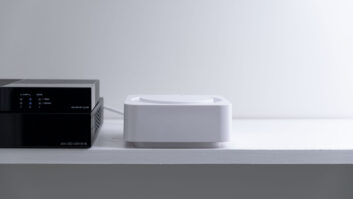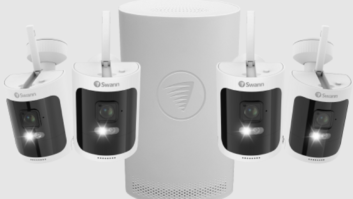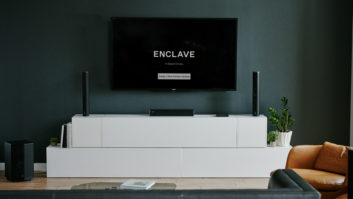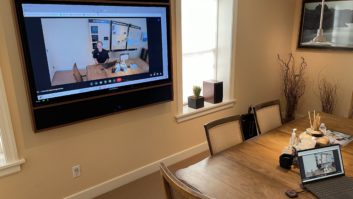Amazing how things work around here. One month were talking about the latest technologies for using wireless communications links for residential systems applications, and no more than a month later things are turning around 180 degrees to look at the wide, wide world of wires.
Even with all of the attention given to sending audio, video and data through the air, it will be a very long time, if ever, before all the wires disappeared. After all, when you take a step back and think about it, wired connections are here to stay when it comes to connecting sources, storage, control and distribution systems. Think about it: what is that skinny thing that plugs into a wireless access point (and were not talking about the power cord)? It isnt a piece of pasta that somehow flew out of the kitchen; its the end link of the signal chain that is being put out on your wireless system.
Wireless not withstanding, things are getting a bit complicated in the world of audio/video interconnects, and it appears that they will stay that way for quite some time. The constantly evolving HDTV picture will make sure of that, as sources such as up-converted DVD players, high-definition DVD players of one format or another, a variety of set-top boxes and server systems and many other products conspire to keep us on our interconnected toes, particularly as content protection/copy control systems will dictate some of the connection specifications. Similarly, the growth of portable player products, led by the astounding success of Apples iPod, will also influence what kind of cables that you will have to provision for a job, and where they fit into the grand system design.
It may be complicated and confusing at times, but remember that it is also profitable. Anyone who has been around the audio/video retail world for any length of time knows that properly merchandized wire, cable and interconnect products can provide a valuable contribution to the bottom line. Anyone who ignores that possibility is clearly in the wrong business.
With video driving many of the upgrades at retail and in custom, it is appropriate to start this months review of the cable landscape with the latest additions to the scene, DVI and HDMI. Originally developed as part of a plug-and-play interconnect scheme to send a digital display signal from computers to projectors and monitors, the Digital Visual Interface, or DVI system of interconnects has become popular in current consumer electronics products thanks to the widespread availability of plugs and components to support it. While DVI will most likely give way over the long the term to the High Definition Multimedia Interface system of cables, the large universe of DVI components means that it is something you will have to deal with for a least a few more years.
In navigating the DVI landscape there is a matrix of connection options that you need to be aware of to assure proper connectivity. First, there is the difference between DVI-I and DVI-D connectors. The former, used primarily with computer displays where backwards compatibility to an analog VGA signal may be required, is easily identified by the four-pin type connections on the corners of a dual flat blade plug holes at the far end of the connector. These four additional pins are needed for the analog video connection, but are simply not needed for the all-digital connections in consumer video displays. Thus, DVI-D connections, found in most consumer sources and displays, have only one flat blade plug slot and drop the four pins.
On a practical level, this is important because the physical differences between the two plug types means that if you pick up cables at a computer fair with male DVI-A plugs, they will not fit into the female DVI-D jacks on consumer video products. However, if for some reason you are using a component such as a commercial or computer monitor with a female DVI-A connection, your male DVI-D plugs will be usable.
The other side of the matrix is the difference between single-link and dual-link DVI cables. While the bandwidth requirement of consumer video systems is not likely to exceed the capability to carry 1920×1080/60P for the foreseeable future, computer systems used for graphics workstations may require higher resolution, higher scan frequencies or both. To serve a variety of masters, the standards groups behind DVI have developed two formats for DVI, single link with a maximum bandwidth of 165 MHz and a dual link system that extends to 330 MHz. Dual link is certainly nice to have, but in the consumer world it is unlikely that you will need it or come across it.
How can you tell the difference between the two? From a visual standpoint it is rather easy. Dual-link connectors have plugs with a full set of 24 pins in the main portion of the connectorthree rows of eight pins. Single-link connectors have only 18 pins, and in reality only use 12 of them. The single-link connectors have two 3×3-pin blocks separated by a gap where the missing six pins used in dual-link connectors would be. Thats the physical side, but what about telling which type of connector is present?
Thats a bit harder, because the plugs on most products have all 24 pins, even when they are only single-link devices. Your best bet is to read the manual or spec sheet.
Take note that dual-link plugs will not work with female single-link jacks. But, that is less of a problem than with DVI-I and DVI-D, because most single-link products have the pinholes, but they are not connected. The important take away is that while dual-link cables can deliver high performance in dual-link devices, there is no benefit to the dual-line capability (and its added cost) when connecting single link devices. Other attributes of the construction of the dual-link products such as better materials, higher purity conductors and improved construction may increase performance, but the added pins bring nothing to the single-link party. On the other hand, knowing that those missing six pins on a single link cable didnt fall out may be helpful when a client looks at plugs and jacks with different numbers of pins and asks you if something is wrong.
DVI is great, and it helped bring full-digital video interconnects to consumer video. As nice as that is, DVI was developed for a different market, and the large connector and thick cable makes it unwieldy for consumer applications. More importantly, the computer-centric nature of DVIs origin did not anticipate the need to accommodate digital audio and control signals. Thats where HDMI steps in.
Created specifically to meet the requirements of consumer products, HDMI uses a smaller connector, about half the width of a DVI plug, and is based on standards that will enable a single connection to carry not only high-definition video, but high bit-rate digital audio and two-way device communication, as well. HDMI is a bit late to the party, but over time that is where the world of HDTV connectivity is going.
With HDMI there is only one 19-pin connector to work about, so the complications of DVI are not an issue here. What may vary with HDMI are not the cable or plugs and jacks, but the standard to which the product with an HDMI jack was built.
The current HDMI standard, released in mid-2004, is HDMI 1.1. Early products may have only been compliant with the older 1.0 standard, and a 2.0 standard is off somewhere in the distance.
At the core level, these different standards do not impact HDMIs primary purpose, which is to carry high-bandwidth digital video signals in a secure fashion from a source (DVD, HDTV tuner, satellite receiver, cable set-top or other similar devices) to a sink device, which is the video display. All HDMI products are capable of doing that. Going further, all HDMI devices are backward compatible with DVI products from a video standpoint. That means that the DVI-equipped satellite receiver or off-air tuner that you installed will absolutely connect to a new HDMI-equipped display, and the DVI equipped display you sold a client last year will display the digital video as output from an HDMI equipped cable set-top that will become available at mid-year. All you need to have to arrange this mixed marriage of DVI and HDMI products is a cable with one connector type on one end, and the opposite type on the other. In addition to dual-format cables, simpler block type adapters are also available.
Where the HDMI to DVI and HDMI to HDMI confusion will crop up is when audio is mixed into the equation. As far as DVI, forget it. You will have to find another way to get the digital audio out from an HDMI-equipped source to the audio system, because DVI just wont handle it. The ability of a device to hear any audio signals that are provided to an HDMI output depends on the standard at hand and the specific capabilities of the device. This is definitely a work in progress, and the best advice is to check with the vendors before relying on HDMI all the way through a system where audio is involved. At this early stage of the game, where multiple versions of the standards are still in play and the devices available to manufacturers are changing rapidly,
there is no pat answer as to what will work with what?
Just remember that it isnt a cable problem, and to read the
spec sheets.
Other than their video standards, HDMI and DVI also share the same nominal cable lengths. Using reasonably good quality cables and connectors, the nominal maximum length for both is about five meters, or about 16 feet. Yes, you can go longer than that, but the cable is going to get big, bulky and expensive. And, remember that both HDMI and DVI are cables that you cannot terminate yourself, so you are stuck to the lengths available from your suppliers and cant really custom tailor these interconnects to the length that you need anymore than you could with USB or 1394.
Some installers have asked how to fit DVI cables through conduit, the length of the cable not withstanding. That is clearly a problem when you need to run a DVI cable to a remote projector or location, since the lack of P-rated DVI (or HDMI) cable at this point means a conduit must be used on some applications, while the sheer size of the DVI connector makes it hard to fish around the bends in a typical conduit run. The length issue, at least for HDMI, will likely be mitigated in the future as chip manufacturers provide solutions that enable HDMI repeaters to become practical and reasonably priced. The other issues may best be addressed, for the time being, with adapter devices that convert DVI or HDMI to fiber or other longer-length transport methodologies.
But thats enough about the digital world of the future. How about a few notes on wiring other less digital products in the wireless world? One seemingly curious place to start is with the wildly popular iPod, which while an intrinsically digital device, only has outputs that are good old fashioned analog left and right audio. How do you hook that up to a sophisticated home audio/video system?
To some extent, the answer is simple an obvious, but look a bit closer and you will likely find some places to create the value-add that separates the true installation professional from the rest of the pack. For example, when your pre-bid interview reveals that the prospect is a big-time iPod user, the first thing you want to do is see if, and how, they access the content aggregated in iTunes in the big room. If it is through a connection to the computer where the iTunes library lives, then the answer may well go back to something wireless, using Apples own Airport Express product to send and/or receive the content. You may also want to consider using a TiVo Series 2 product, which has the ability to see iTunes content and play it out into a remote rooms system.
However, in most cases you will find that it is the iPod itself doing local playback, which means that you will need to use a 3.5mm mini-plug to (in 99 percent of the cases) dual RCA plug adapter. Here is where the fun begins. While it may seem like overkill, rather than using an inexpensive black cable that is likely to have little or any shielding, consider a step-up product from the likes of Monster Cable, Belkin or one of the many other companies that have jumped on the iPod Accessories bandwagon. Youll find that the product will not only present a much better appearance, but it will likely work better, as well.
For those not familiar with iPods, when confronted with the need to provide a local connection you should also consider adding an extra dock and the associated charging cable in the remote room. This assures that the iPod will not just be slapped down on top of a shelf where it could possible fall off, but that there will be power to make sure the unit keeps running. The backs of the docks provide connections for both the audio output and to an external charger. A side note is that if you take advantage of the airport device to stream content from iTunes to a remote audio system, you do have the option of a standard analog output, or a PCM output through an optical connection.
Although iPod has almost become the generic description of a portable music player for some, it is neither generic nor the only solution. A number of manufacturers have competitive products that have their own pros and cons when judged against iPod. It is a good bet that many of your clients and prospects, or their offspring, will be users of one or the other of these, but dont presume that it is always going to be an iPod. The good news is that the 3.5mm plug is somewhat universal in getting the audio out of these devices, but there is no universal standard for the connections to docks and chargers. Inquire with the manufacturer of the products to be used, and then be certain to make your clients aware that as they switch and upgrade from one type of portable player to another, even within the iPod world, the connections may change. The point of contact with a client over something as small as that is a great way to maintain visibility for upgrade business.
Keeping things connected is where many in the custom business got their start, typically when working at a traditional retailer that didnt have a means to assist customers in linking together the products they had just purchased. From those small one-person businesses, our industry has blossomed, but even in the wireless world the use of interconnects is always at the core. Whether it is the complex digital world of DVI and HDMI, or the deceptively not-so-simple task of figuring out how to connect a portable player to a large system, knowing which connection to use will keep you wired for business.
Michael Heiss ([email protected]) is a technology and marketing consultant based in Los Angeles.







